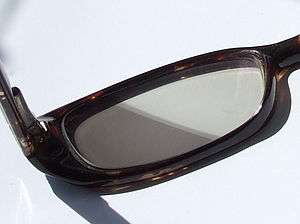Photochromic lens

Photochromic lenses are optical lenses that darken on exposure to specific types of light of sufficient intensity, most commonly ultraviolet (UV) radiation. In the absence of activating light the lenses return to their clear state. Photochromic lenses may be made of glass, polycarbonate, or another plastic. They are principally used in eyeglasses that are dark in bright sunlight, but clear in low ambient light conditions. They darken significantly within about a minute of exposure to bright light, and take somewhat longer to clear. A range of clear and dark transmittances are available; one manufacturer makes one glass with transmittance reducing from 87% to 20%, and another reducing from 45% to 9%.
In one sort of technology, molecules of silver chloride or another silver halide are embedded in photochromatic lenses. They are transparent to visible light without significant ultraviolet component, which is normal for artificial lighting. In another sort of technology, organic photochromic molecules, when exposed to ultraviolet (UV) rays as in direct sunlight, undergo a chemical process that causes them to change shape and absorb a significant percentage of the visible light, i.e., they darken. These processes are reversible; once the lens is removed from strong sources of UV rays the photochromic compounds return to their transparent state.
Invention
Photochromic lenses were developed by Roger Araujo at the Corning Glass Works Inc. in the 1960s, and the process was used in the first mass-produced variable tint lenses.
Technical details
The glass version of these lenses achieve their photochromic properties through the embedding of microcrystalline silver halides (usually silver chloride) in a glass substrate. Plastic photochromic lenses use organic photochromic molecules (for example oxazines and naphthopyrans) to achieve the reversible darkening effect. These lenses darken when exposed to ultraviolet light of the intensity present in sunlight, but not in artificial light.
With the photochromic material dispersed in the glass substrate, the degree of darkening depends on the thickness of glass, which poses problems with variable-thickness lenses in prescription glasses. With plastic lenses, the material is typically embedded into the surface layer of the plastic in a uniform thickness of up to 150 µm.
Typically, photochromic lenses darken substantially in response to UV light in less than one minute, and continue to darken a little more over the next fifteen minutes.[1] The lenses begin to clear in the absence of UV light, and will be noticeably lighter within two minutes, mostly clear within five minutes, and fully back to their non-exposed state in about fifteen minutes. A report by the Institute of Ophthalmology at the University College London suggested that at their clearest photochromic lenses can absorb up to 20% of ambient light.[2]
Because photochromic compounds fade back to their clear state by a thermal process, the higher the temperature, the less dark photochromic lenses will be. This thermal effect is called "temperature dependency" and prevents these devices from achieving true sunglass darkness in very hot weather. Conversely, photochromic lenses will get very dark in cold weather conditions. Once inside, away from the triggering UV light, the cold lenses take longer to regain their transparency than warm lenses.
A number of sunglass manufacturers and suppliers including Tifosi, Intercast, Oakley, Serengeti Eyewear, and Persol provide tinted lenses that use photochromism to go from a dark to a darker state. They are typically used for outdoor sunglasses rather than as general-purpose lenses.
References
- ↑ http://en-us.transitions.com/Why-Transitions/The-Technology/
- ↑ Selva Kumar (19 April 2007). "UCL in the News: Lookout's lenses blamed for sea accident". UCL News. Retrieved 28 February 2014.
External links
- "Photochromic lenses", How stuff works.
- "Optometry Glossary", Perfect glasses, USA.